Content for TS 24.502 Word version: 19.0.0
9 Parameters and coding
9.1 General
9.2 3GPP specific coding information
9.2.1 GUAMI
9.2.2 Establishment cause for non-3GPP access
9.2.3 PLMN ID
9.2.4 IKEv2 Notify Message Type value
9.2.4.1 General
9.2.4.2 Private Notify Message - Error Types
9.2.4.3 Private Notify Message - Status Types
9.2.5 TNGF IPv4 contact info
9.2.6 TNGF IPv6 contact info
9.2.7 NID
...
...
9 Parameters and coding p. 81
9.1 General p. 81
This clause describes the encoding of the parameters which are exchanged between the UE and the network. This clause is further divided into three clauses; 3GPP specific coding information, IETF specific coding information and NAS message envelope.
The clauses for the 3GPP specific coding information and IETF specific coding information describe how to encode the messages and parameters belonging to 3GPP and IETF. The clause for NAS message envelope describes how to encode the NAS message envelope in order to frame a NAS message prior to its encapsulation within a TCP payload.
9.2 3GPP specific coding information p. 81
9.2.1 GUAMI p. 81
The purpose of the GUAMI information element is to provide the globally unique AMF ID.
The GUAMI information element is coded as shown in Figure 9.2.1-1 and Table 9.2.1-1.
The GUAMI is a type 3 information element with a length of 7 octets.
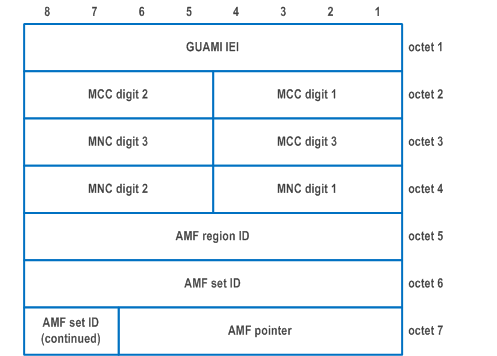
| MCC, Mobile country code (octet 2, octet 3 bits 1 to 4) | |
| The MCC field is coded as in ITU-T Recommendation E.212 [21], Annex A. | |
| MNC, Mobile network code (octet 4, octet 3 bits 5 to 8). | |
| The coding of this field is the responsibility of each administration but BCD coding shall be used. The MNC shall consist of 2 or 3 digits. If a network operator decides to use only two digits in the MNC, bits 5 to 8 of octet 3 shall be coded as "1111". | |
| AMF Region ID (octet 5) | |
| This field contains the binary encoding of the AMF Region ID. Bit 8 of octet 5 is the most significant bit and bit 1 of octet 5 is the least significant bit. | |
| AMF Set ID (octet 6, octet 7 bits 7 to 8) | |
| This field contains the binary encoding of the AMF Set ID. Bit 8 of octet 6 is the most significant bit and bit 7 of octet 7 is the least significant bit. | |
| AMF Pointer (octet 7 bits 1 to 6) | |
| This field contains the binary encoding of the AMF Pointer. Bit 6 of octet 7 is the most significant bit and bit 1 of octet 7 is the least significant bit. | |
9.2.2 Establishment cause for non-3GPP access p. 82
The purpose of the Establishment cause for non-3GPP access information element is to provide the establishment cause for non-3GPP access.
The Establishment cause for non-3GPP access information element is coded as shown in Figure 9.2.2-1 and Table 9.2.2-1.
The Establishment cause for non-3GPP access is a type 3 information element with length of 2 octets.

| Establishment cause for non-3GPP access (N3AEC) (octet 2 bits 1 to 4) | |
| Bits
4 3 2 1 | |
| 0 0 0 0 | emergency |
| 0 0 0 1 | highPriorityAccess |
| 0 0 1 1 | mo-Signalling |
| 0 1 0 0 | mo-Data |
| 1 0 0 0 | mps-PriorityAccess |
| 1 0 0 1 | mcs-PriorityAccess |
| 1 0 1 0 | mo-SMS |
| 1 0 1 1 | mo-VoiceCall |
| 1 1 0 0 | mo-VideoCall |
| All other values are spare values. The receiving entity shall treat a spare value as 0100, "mo-Data". | |
9.2.3 PLMN ID p. 83
The purpose of the PLMN ID information element is to indicate the PLMN identity of the selected PLMN.
The PLMN ID is a type 4 information element with a length of 5 octets.
The PLMN ID information element is coded as shown in Figure 9.2.3-1 and Table 9.2.3-1.
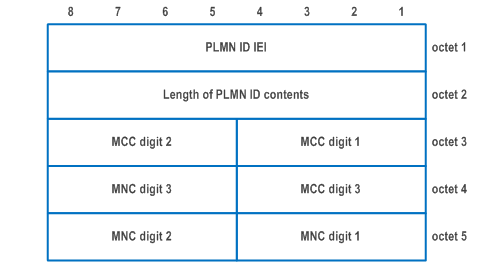
| MCC, Mobile country code (octet 3, octet 4 bits 1 to 4) | |
| The MCC field is coded as in ITU-T Recommendation E.212 [42], Annex A | |
| MNC, Mobile network code (octet 5, octet 4 bits 5 to 8) | |
| The coding of this field is the responsibility of each administration but BCD coding shall be used. The MNC shall consist of 2 or 3 digits. If a network operator decides to use only two digits in the MNC, bits 5 to 8 of octet 4 shall be coded as "1111". Mobile equipment shall accept MNC coded in such a way. | |
9.2.4 IKEv2 Notify Message Type value p. 83
9.2.4.1 General p. 83
The IKEv2 Notify Message Type is specified in RFC 7296.
The Notify Message Type with a value (in decimal) in the range 0 - 16383 is intended for reporting errors, where:
- value range between 0 and 8191 is defined in RFC 7296; and
- value range between 8192 and 16383 is reserved for private error usage.
- value range between 16384 and 40959 is defined in RFC 7296; and
- value range between 40960 and 65535 is reserved for private status usage.
9.2.4.2 Private Notify Message - Error Types p. 84
The Private Notify Message Error Types defined in Table 9.2.4.2-1 are error notifications which indicate an error while negotiating an IKEv2 SA or IPsec SA. Refer to Table 9.2.4.2-1 for more details on what each error type means.
| Notify Message | Value (in decimal) | Descriptions |
|---|---|---|
| CONGESTION | 15500 | This error type is used to indicate that the requested service was rejected because of congestion in the network. |
| NO_RESOURCES_OVER_N3GPP | 15501 | This error type is used by the UE to indicate the failure of reserving the QoS resources over non-3GPP access for the QoS flows associated with the child SA. |
In the present specification, only the private notify message error type values between 15500 and 15599 shall be allocated to a Notify payload.
The private notify message error type values:
- between 9950 and 9999;
- between 10950 and 10999;
- between 11950 and 11999;
- between 12950 and 12999;
- between 13950 and 13999; and
- between 14950 and 14999;
9.2.4.3 Private Notify Message - Status Types p. 84
The Private Notify Message Status Types defined in Table 9.2.4.3-1 are used to indicate status notifications or additional information in a Notify payload which may be added to an IKEv2 message or IKE_AUTH request or IKE_AUTH response message according to the procedures described in the present document. Refer to Table 9.2.4.3-1 for more details on what each status type means.
| Notify Message | Value (in decimal) | Descriptions |
|---|---|---|
| 5G_QOS_INFO | 55501 | This status when present indicates 5G_QOS_INFO Notify payload encoded according to clause 9.3.1.1. |
| NAS_IP4_ADDRESS | 55502 | This status when present indicates NAS_IP4_ADDRESS Notify payload encoded according to clause 9.3.1.2. |
| NAS_IP6_ADDRESS | 55503 | This status when present indicates NAS_IP6_ADDRESS Notify payload encoded according to clause 9.3.1.3. |
| UP_IP4_ADDRESS | 55504 | This status when present indicates UP_IP4_ADDRESS Notify payload encoded according to clause 9.3.1.4. |
| UP_IP6_ADDRESS | 55505 | This status when present indicates UP_IP6_ADDRESS Notify payload encoded according to clause 9.3.1.5. |
| NAS_TCP_PORT | 55506 | This status when present indicates NAS_TCP_PORT Notify payload encoded according to clause 9.3.1.6. |
| N3GPP_BACKOFF_TIMER | 55507 | This status when present indicates N3GPP_BACKOFF_TIMER Notify payload encoded according to clause 9.3.1.7. |
| UP_SA_INFO | 55508 | This status when present indicates UP_SA_INFO Notify payload encoded according to clause 9.3.1.8. |
In the present specification, only the private notify message status type values between 55500 and 55599 shall be allocated to a Notify payload.
The private notify message status type values:
- between 49950 and 49999;
- between 50950 and 50999;
- between 51950 and 51999;
- between 52950 and 52999;
- between 53950 and 53999; and
- between 54950 and 54999;
9.2.5 TNGF IPv4 contact info |R16| p. 85
The purpose of the TNGF IPv4 contact info information element is to indicate the IPv4 address of the TNGF to be used for IKE SA establishment over trusted non-3GPP access network.
The TNGF IPv4 contact info is a type 4 information element with a length of 6 octets.
The TNGF IPv4 contact info information element is coded as shown in Figure 9.2.5-1 and Table 9.2.5-1.
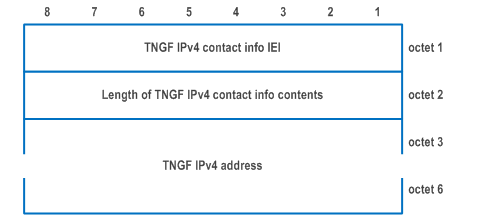
| TNGF IPv4 address contains IPv4 address of the TNGF for IKE SA establishment over trusted non-3GPP access network. | |
9.2.6 TNGF IPv6 contact info |R16| p. 86
The purpose of the TNGF IPv6 contact info information element is to indicate the IPv6 address of the TNGF to be used for IKE SA establishment.
The TNGF IPv6 contact info is a type 4 information element with a length of 18 octets.
The TNGF IPv6 contact info information element is coded as shown in Figure 9.2.6-1 and Table 9.2.6-1.
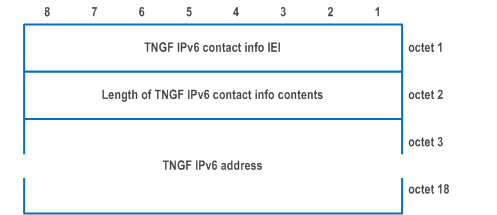
| TNGF IPv6 address contains IPv6 address of the TNGF for IKE SA establishment over trusted non-3GPP access network. | |
9.2.7 NID |R16| p. 86
The purpose of the NID information element is to indicate the NID of the selected SNPN.
The NID is a type 4 information element with a length of 8 octets.
The NID information element is coded as shown in Figure 9.2.7-1, Figure 9.2.7-2, Table 9.2.7-1 and Table 9.2.7-2.
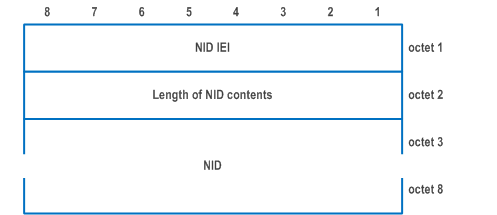
| NID (octet 3 to octet 8) | |
| NID field is coded according to Figure 9.2.7-2 and Table 9.2.7-2 | |
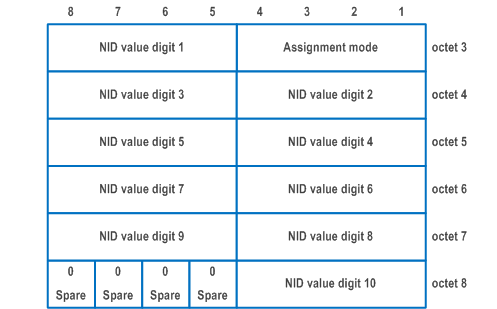
| Assignment mode (octet 3 bits 1 to 4) | |
| This field contains the binary encoding of the assignment mode of the NID as defined in TS 23.003. | |
| NID value (octet 3 bits 5 to 8, octets 4 to 7, octet 8 bits 1 to 4) | |
| This field contains the binary encoding of each hexadecimal digit of the NID value as defined in TS 23.003. | |
| Bits 5 to 8 of octet 8 are spare and shall be coded as zero. | |